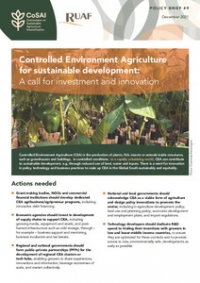The research project seeks to test Bhungroo Irrigation Technology (BIT) among smallholder women farmers in the Northern region of Ghana. Waterlogging and flooding are major factors impeding agricultural productivity in the Northern regions of Ghana particularly the NorthernNorthern region. The situation is due to the erratic rainfall patterns resulting from climate change and the overflowing of the Volta due to the opening of the Bagre Dam in Burkina Faso. Flooding and waterlogging negatively affects agriculture productivity particularly for women and youth farmers, by limiting their ability to access farmlands, destroying farm crops and also leading to the prevalence of crop diseases. Unfortunately, during the dry season, most of these waterlogged farmlands get totally dry, with limited access to irrigation facilities for the farmers. Hence these farmers suffer excess water during the wet season, and also limited water during the dry season. Bhungroo is technology that frees waterlogged/flooded farmlands of excess water during the rainy season, stores water underground naturally in unsaturated layers of soil, and pumps water for farming during the dry season. A single Bhungroo has the potential to free five acres of flooded farmland, and store at least 2-4 million liters of water in unsaturated layers of soils. The stored water is extracted from underground using a pump machine. Bhungroo is drilled at the lowest point of a target area between depths of 60- 110 ft. This research seek to investigate the potential to use Bhungroo as a tool to conserve water for farmers to use. The research will further explore how the Bhungroo can contribute to enhancing ecosystem services. This is due to Bhungroo providing water at the door step of farmers. The research seeks to answer a number of questions regarding the introduction of the Bhungroo to the project area. They include identifying the extent to which the soils in the project area can hold and retain water for farming particularly in the dry season. Additionally, the research will seek to identify and measure crop production under Bhungroo compared to traditional irrigation system, and lastly the research will find out the perception of the various rural riparian communities on natural resource and governance. In this research, the following outputs are anticipated; three Bhungroo demonstration plots established within three communities for water storage, information regarding the level of performance of the Bhungroo, comparative information of production trends of Bhungroo against traditional systems, and lastly the perceptions of rural communities on natural resource and governance. On the other hand, the expected outcomes include; Bhungroo demonstration plots will offer opportunity for three farming communities, GIDA and the district assembly to compare the performance of the Bhungroo scheme against the traditional system of irrigation on water management, dry season agricultural production and natural resource management within two years of project implementation. Additionally, at least 50% of participating farmers are knowledgeable about the adverse effect of farming within riparian buffers during the dry season and within the 2-year project implementation period The gender approach of the project lies in the fact that it target primarily resource poor farmers in the area. The simplicity and labour saving nature of the technology, makes it user friendly and highly accepted by women as in the case of India. The gender approach in the research is also the focus on vegetable farming in the area, which over 75 percent of farmers in the area are women. The project seeks to enhance the belief that a gender based approach in irrigation development will achieve greater results, than an intervention solely focused on men. The research will generate various relevant information on irrigations systems, production systems, farmer perceptions, riparian buffers and socio-ecological data, which could help inform policy makers in designing appropriate strategies on irrigation and ecosystem services. The communal management of the Bhungroo in accordance with the traditional protocols on natural resource management will further deepen the bonds among individuals in the communities. This will promote community ownership of the project. Lastly, building and improving knowledge among communities on ecosystem services will contribute to reducing pressure of buffer zones.
menu

















